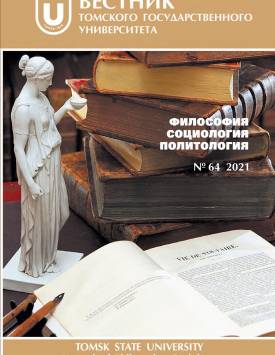On the Polyethnicity of the Republic of Buryatia
The perception of polyethnicity as an important feature of modern society is based on the subject’s reaction to differences. Polyethnicity implies a presence in the structure of the social community of representatives of two or more ethnic groups. Usually polyethnicity is a result of objective social processes, which happened in Russia too. Today the Russian Federation is a polyethnic country, and almost all subjects of the federation are polyethnic. The main types of polyethnicity are traditional (a rich experience of interethnic interaction of people, large number of old residents with different ethnic origins that formed the polyethnic core of the settlement/region) and new, formed in the 20th century. It is advisable to differentiate individuals living in polyethnic environments as old residents and newcomers according to the criterion of duration. The polyethnicity of Buryatia was formed during several centuries and gradually became one of the features of people’s lifestyle. The internationalist course of the Soviet state’s politics coincided with the long established trend of interethnic interaction and was loyally received by the population. The polyethnicity of this region may be called positive, as it is characterised by interethnic tolerance and consent of peoples. The specificity of Buryatia’s polyethnicity is that its core is two ethnoses: Russians and Buryats. Interethnic tolerance and consent are among the causes of Buryaria’s attractiveness for contemporary migrants from post-Soviet countries. Although, in general, migrants’ well-being in the republic and interaction with local residents is assessed as positive, there is some difference in the perception of newcomers, on the one hand, by old residents, especially indigenous townspeople belonging to older age groups adapted to racial and ethnic otherness since Soviet times, and, on the other hand, by local residents of the first generation and rural residents. The latter socialized in the post-Soviet period and are fully experiencing the difficulties of living in a remote, subsidized, economically and socially nonprosperous, or simply poor, republic; they do not have much experience of communicating outside their habitual environment of ethnic groups dominating in the republic; for them visitors from afar are sometimes the “visible ethnic Others”. Due to factors of an objective nature, visitors from the countries of Central Asia, the Caucasus, and, possibly, some republics of southern Russia, in the near future can make up a more noticeable part of the inhabitants of Buryatia. With such a forecast, much depends on the level of public administration in the country and the region, and, of course, on the preservation of the traditional positive polyethnicity of Buryatia.
Keywords
polyethnicity, Republic of Buryatia, Buryats, Russians, polyethnic regionAuthors
| Name | Organization | |
| Chimitova Irina Z. | Buryat State Agricultural Academy | rindaol@mail.ru |
References

On the Polyethnicity of the Republic of Buryatia | Tomsk State University Journal of Philosophy, Sociology and Political Science. 2021. № 64. DOI: 10.17223/1998863X/64/16
